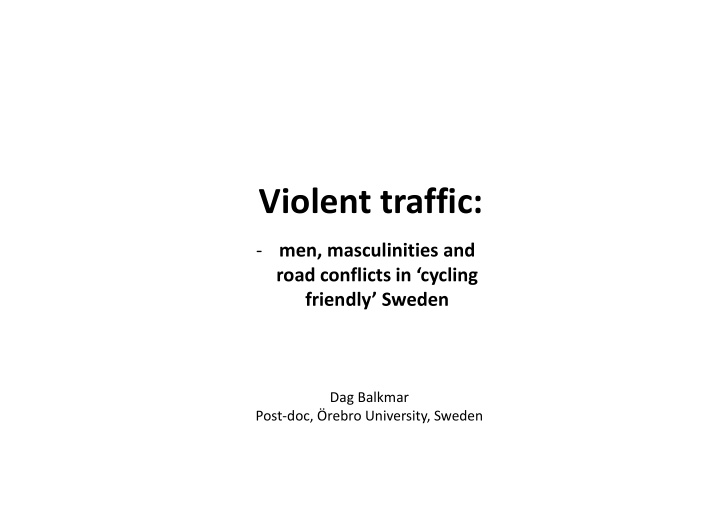



Violent traffic: ‐ men, masculinities and road conflicts in ‘cycling friendly’ Sweden Dag Balkmar Post ‐ doc, Örebro University, Sweden
Aim: to discuss cyclist’s situation in traffic ‐ dense environments from an intersectional gender and violence perspective.
In the wake of the ‘cycling boom’ in Stockholm city • Sweden as cycling ‘friendly’, cycling as ‘normal’, around 9 ‐ 10 percent cycle everyday • Stockholm: 150 000 cyclists/day, an increase of 70 % in a decade. • Problem: too little space for cyclists – conflicts • Inner city cyclists: 50/50 men/women, middle class, well educated, cycling for well being
Theorizing violence in traffic • An intersectional approach • Violence defined as actions, structures, events and experiences that violate or cause violation or are considered as violating (Hearn and Parkin 2001, 18). • A focus on men and masculinities: privilege, mobilities, vulnerabilities, violences
Material and methodology • Material: 1) media, 2) policy, 3) interviews and 4) online ‐ discussions amongst cyclists • Selected threads on everyday cycling and conflicts.
Online cycling communities • Happymtb.org, fixedgear.se
A threat of violence • there was this girl cycling in front of me and she said something to somebody who had parked in the cycling lane and then he chased her up onto the sidewalk with his car. So, there is a threat of violence, some form of violence present, and one becomes, you know, I am not so used with it so it becomes unpleasant. It doesn't make me stop cycling, I like it too much, but it does put me on guard and in some parts of the city it makes me more watchful. (Woman, 45 years old, commuter, Stockholm)
”cars who wants to make a point” • My friend got a beer bottle thrown at him, I have got cheese doodles thrown at me when cycling and a couple of middle fingers pointed at me. I usually wave back rather than giving the finger in return. Of course you get scared stiff when you almost get hit. One have to make sure not to provoke any additional anger and try to calm things down a bit. (Man, 41 years old).
Imagining revenge “I usually do not do much, like, hit the car. It’s fun the thing with opening the car doors, people feel really safe in their tin can and when someone opens the door the illusion sort of bursts and they end up in sort of a chock.“ (Fixedgear.se)
“Just to make a short story even shorter. 20 minutes ago I got hit, or forced to stop. My front wheel ended up underneath his right front wheel which forced me to play leap ‐ frog over my handlebars. The adrenaline really hit and now there is a newish Volvo V70 rolling around with a big fist in the bonnet.” (Fixedgear.se)
From violence to self control “A catchword for next week: Pass around the idiots. Smile at the idiots. Laugh at their mistakes. Adjust to the situation. Adapt to the situation.” (fixedgear.se)
A violent road to sustainable mobility? • A normalized problem that produces insecurity • About (male) drivers using their cars to reinstate traffic hierarchies, power and control in traffic space. • Understand the hegemony of the car and the built environment making possible for certain men to perform their ‘right to the road’, including the gender identity shaping practices, and the effects of cyclists violated bodily integrity • Violent mobilities may reduce cycling and reproduce gendered mobility patterns. • However, both men and women negotiate vulnerability: from online revenge ‐ talk to avoidance and adaption.
Contact: dag.balkmar@oru.se Thanks!
Recommend
More recommend